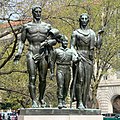Modern Art Foundry
 Modern art foundry logo | |
| Industry | Foundry |
|---|---|
| Founded | 1932 |
| Founder | John Spring [1] |
| Headquarters | 18-70 41st Street Astoria, New York 11105, United States |
Key people | Jeffrey Spring, President[2] |
| Website | www |
The Modern Art Foundry is an historic foundry in Astoria, Queens, New York, founded in 1932 by John Spring. His descendants continue to operate the business[3] in what used to be the carriage house of the Steinway Mansion.[2]
Modern Art Foundry specializes in working with artists who create limited edition works, usually intended for museums and galleries.[4] The foundry utilizes the lost-wax casting method for producing its large-scale work.[3] It also does maintenance and conservation of existing works.[5]
History[]
John Spring, a Polish immigrant, started his business in 1932 on Astoria Boulevard, at the end near what is now the Socrates Sculpture Park.[4] In 1947, the foundry moved from its location near the East River to where it is at present.[2] Spring built the business on close relationships with a small group of "prominent and prolific" artists. Among the artists who have worked there are Jose de Creeft, Jacques Lipchitz, Louise Bourgeois,[3] Gaston Lachaise, Joan Miró, Alexander Archipenko, and Isamu Noguchi.[6]
Operations[]
In contrast to most foundries that have switched over to ceramic shell casting, Modern Art utilizes the lost-wax casting method for producing its large-scale work.[3] Workers first create a wax copy of the artist's original model and then apply a plastic coating to it. The mold is then fired in a kiln, which causes the wax to melt away. Molten bronze is then poured into the mold. This method yields an exact bronze replica of the artist's original model.[3]
The foundry is known for its exacting and innovative work. Bourgeois chose the foundry to cast the Maman sculpture because of its reputation and output.[3] In the early 1960s, Jasper Johns cast "Light Bulb," "Flashlight; Painted Bronze (ale cans)", "Painted Bronze (paintbrushes)", "Flag", and "Bronze (Light Bulb, Socket, Wire on Grid" at the foundry.[7]
In 2002, artisans at the foundry replaced the original zinc statues that were part of the 1867 Civil War Soldiers Monument in the Green-Wood Cemetery, Brooklyn, with bronze replicas.[8]
Gallery[]

Hans Christian Andersen, by Georg John Lober, located in Central Park

The Ideal Scout by R. Tait McKenzie in Philadelphia and other locations

Boy Scout Memorial by Donald De Lue, located at The Ellipse in Washington, D.C.
Auswandererdenkmal (Emigrant Memorial) by Frank Varga, located in Bremerhaven, Germany
Alice in Wonderland sculpture by Jose de Creeft, located in Central Park

Maman by Bourgeois

Sophocles in Athens Square Park[9]

Garment Worker by Judith Weller[4]

Soldier's Monument at Green-Wood Cemetery
References[]
- ^ Jeffrey Spring. "About". Modern Art Foundry. Retrieved January 26, 2007.
- ^ Jump up to: a b c Mukhi, Karun (November 14, 2016). "The Modern Art Foundry, A Jewel Hidden in Plain Sight in the Steinway Mansion Carriage House". Retrieved August 15, 2019.
- ^ Jump up to: a b c d e f Anderson, Nicole Gates (September 6, 2012). "Where Bronze Transforms Into Fine Art". The New York Times.
- ^ Jump up to: a b c Evelly, Jeanmarie. "See Inside The 85-Year-Old Astoria Foundry Where Famous Sculptures Get Made". Astoria & Long Island City. DNAinfo. Archived from the original on November 18, 2017. Retrieved May 19, 2017.
- ^ "Modern Art Foundry". JebusandAndrea. May 27, 2017.
- ^ Freudenheim, Ellen (2013). Queens What to Do, Where to Go (and How Not to Get Lost) in New York's Undiscovered Borough. St. Martin's Publishing Group. p. 38. ISBN 9781466852389.
- ^ Leggio, James; Weiley, Susan (1991). John Elderfield (ed.). American Art of the 1960s. New York: Museum of Modern Art. p. 62. ISBN 9780870704581.
- ^ "Modern Art Foundry Recreates Civil War Statue". Queens Scene Magazine. August 15, 2019.
- ^ Evelly, Jeanmarie. "7-Foot Sophocles is Final Piece in Astoria Park Greek Statues Collection". Astoria & Long Island City. DNAinfo. Archived from the original on August 28, 2019. Retrieved March 18, 2015.
External links[]
 Media related to Modern Art Foundry at Wikimedia Commons
Media related to Modern Art Foundry at Wikimedia Commons- "Modern Art Foundry". Made in NYC. Retrieved May 4, 2005.
- Modern Art Foundry's channel on YouTube
- Richman, Jeff (October 8, 2015). "Another Mystery Solved". The Green-Wood Historic Fund.
Coordinates: 40°46′43″N 73°53′53″W / 40.77853°N 73.89815°W
- 1932 establishments in New York (state)
- American companies established in 1932
- Astoria, Queens
- Companies based in Queens, New York
- Foundries in the United States
- Industrial buildings and structures in New York (state)
- Manufacturing companies based in New York City









